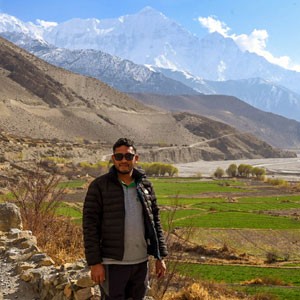How difficult is Everest Base Camp Trek? Delve into the challenges of this high-altitude adventure, including physical fitness requirements, harsh terrain, and varying weather conditions. Equip yourself with our comprehensive guide for a successful ascent.
How Difficult is Everest Base Camp Trek?
Table of Contents
It is unfathomable dream of every travel enthusiast to be able to stand in the base of the highest mountain of the world, Mount Everest and divine beauty of it. Every year thousands of trekkers make their way to the top of Mount Everest to pursue such dreams. And of course, some of them aspire to climb all the way to the top of the mountain. Many trekkers dream come true by reaching to the base camp of Everest whereas a few of them are unable to do so. Now, you might be wondering how difficult is Everest base camp trek in actual.
Honestly, the difficulty level of Everest base camp trek differs from person to person. The factors like physical fitness, mental health, prior trekking experience, prior planning and packing also influence the difficulty level of Everest base camp trek. Thus, some may find this trek easy whereas other may take this trek as a hard one. Read the full article to have a decent knowledge about the difficulties that arises during Everest base camp trek and ways to overcome them.
What factors make the Everest base camp trek challenging one?
The factors that make the Everest base camp trek quite a challenging one are described briefly in this article.
Length of Everest base camp trek
Most part of the Everest region lacks the facility of road and transportation. Thus the only way to explore the mountains is by walking through the Khumbu region from Lukla. The distance from Lukla to Everest base camp is 65 km. The total distance covered in a round trip 130 km. Therefore, trekkers must walk around 6-8 hours every day in the rough and rocky terrain of the Everest region.
Everest base camp trek requires minimum 12 days for its successful completion. The journey can feel like forever and can be difficult for a novice trekker to complete. The length of this trek results in extreme fatigueness for novice trekkers. Hiring a porter can help you to reduce some stress in your body with porter carrying your heavy backpacks where you will be less prone to fatigueness.
Prior to their trek, one must be mentally prepared for the long and tiring walks to reach base camp and back to Lukla. This way the challenges due to the length of trek might become easier to overcome.
Increasing altitude of Everest base camp
Increasing altitude is the most significant factor for causing the difficulties throughout the Everest base camp trek, yet most of the trekkers underestimate it. Tribhuvan International airport is situated at an elevation of 1200m while the airport of Lukla is situated at 2800 m. This increase in elevation is covered within 35 minutes by flight. The sudden increase in altitude is capable enough to induce the person with mild altitude sickness.
During the trek, the elevation increases 600-800 m every day therefore the oxygen level decreases moderately. This increase in altitude can cause acute mountain sickness or altitude sickness. Every trekker is prone to altitude sickness irrespective of their age and physical fitness. It is therefore significant to walk slowly and gradually in order to prevent altitude sickness. Likewise plan your itinerary with at least two acclimatization or rest day to adjust your body with the drastic increase in elevation. While trekking drink plenty of water to stay hydrated. Following these instructions will certainly contribute to adjust to increasing elevation throughout the trek.
Lack of training for the trek
Everest Best Camp Trek is relatively easier than Annapurna Base Came Trek. However, this doesn’t mean that the Everest Base Camp Trek should by understimated by any means. Hiking in the rough and rocky terrain of Himalayas is a grave challenge. Therefore, it is mandatory to have proper training sessions prior to Trek. With proper planning and training, one will be able to complete the most extravagant trek in the world.
It is sensible to start training three months prior to your scheduled trek. During the training period, one should focus on conventional exercise trek Swimming, Jogging Cycling which contribute in body strength fitness and stamina .Likewise light weight-training is substantial if your fitness level is less than desirable. If possible, walk atleast everyday to increase the capacity of lungs as well as the stamina of your body. These training activity will play a significant role in determining the difficulty of this trek. A physically fit individual will complete Everest Base Camp Short Trek without any hinderance.
Improper Diet / Food poisoning while trekking
While trekking in Himalayas, the individual must eat proper diet in order tobe safe from food poisoning. There are several cases where trekking abandon their trek and return to Kathmandu for the treatment of food poisoning. Then the question arises what should we eat while trekking in the Everest region. Trekkers must avoid consuming non-veg items in the Everest region trek to avoid food poisoning. Thus is because, meat is brought from lower region to upper region taking several days making the meat very stale to consume. Thus, we do not recommend you to eat food containing meat. Moreover, avoid drinking alcohol as it is the main cause of dehydration.
While trekking it is better to consume freshly prepared local Nepali cusine which includes rice, lentils and curry. The regular Nepali food will give you enough energy to sustain in the Himalayan terrain. Drink plenty of water to keep your body hydrated throughout the trek. Drinking water is sold at local teahouse along the trekking route or you can carry water purification tablets and drink the tab water after purification.

